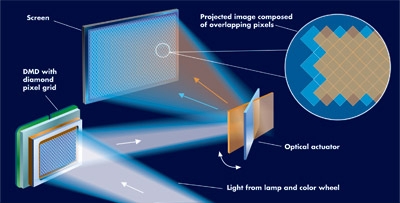Special Report: Mitsubishi WD-52627 HDTV Page 3

Pixel Magic: How TI Puts the 1080p in DLP Digital Light Processing (DLP) is today's most-popular fixed-pixel, or "microdisplay," rear-projection technology. It relies on a chip - called a DMD, or Digital Micromirror Device - that's covered with microscopic mirrors, each representing one pixel of light on the screen. But rather than try to mass-produce a chip with all 2 million-plus mirrors needed to create a 1080p image, DLP developer Texas Instruments took a different route.
Using an HP technique known as "wobulation" (TI calls it SmoothPicture), TI achieves a 1,920 x 1,080 effective pixel resolution using half that number of mirrors. Wobulation relies on the same principle as interlacing, which shows half the picture at a time, but so rapidly the eye combines the two parts into one. Starting with the square pixel design of its 720p DLP chips, TI turned each mirror 45° relative to the sides of the display, creating rows of diamond-shaped pixels. There are only 960 x 1,080 micromirrors on the grid, but each of them, in effect, creates two separate pixels, one after the other.
During operation, light from the lamp bounces from the chip to a device called an optical actuator, a reflective panel that pivots. In its first position, the actuator reflects half of the image information (the odd-numbered pixels) onto the screen. After 8 milliseconds, the actuator switches position - or "wobulates" - half a pixel-width. Simultaneously, the chip flashes up the picture information for the other half of the image (the even-numbered pixels). This process is so quick that it's impossible to differentiate between the sets of pixels, and the entire frame, with all 1,920 x 1,080 pixels, is "constructed" within the standard 1/60-second field time. -D.K.
- Log in or register to post comments




















































